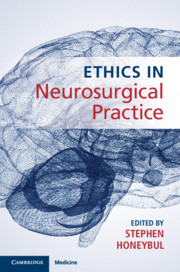Book contents
- Ethics in Neurosurgical Practice
- Ethics in Neurosurgical Practice
- Copyright page
- Contents
- Contributors
- Introduction
- Part I General Ethics
- Part II Neurosurgery-Specific Bioethics
- Chapter 10 A Historical Overview of Ethics in Neurosurgery
- Chapter 11 Evidence-Based Neurosurgery: Principles, Applicability, and Challenges
- Chapter 12 Ethical Challenges of Neurosurgical Care for Brain Tumour Patients
- Chapter 13 Severe Traumatic Brain Injury
- Chapter 14 ‘Malignant’ Middle Cerebral Artery Infarction
- Chapter 15 Aneurysmal Subarachnoid Haemorrhage
- Chapter 16 Paediatric Neurosurgery
- Chapter 17 Spinal Neurosurgery
- Chapter 18 Ethical Challenges in Psychosurgery: A New Start or More of the Same?
- Chapter 19 Brain Death and Organ Donation
- Part III Future Developments
- Index
- References
Chapter 18 - Ethical Challenges in Psychosurgery: A New Start or More of the Same?
from Part II - Neurosurgery-Specific Bioethics
Published online by Cambridge University Press: 29 May 2020
- Ethics in Neurosurgical Practice
- Ethics in Neurosurgical Practice
- Copyright page
- Contents
- Contributors
- Introduction
- Part I General Ethics
- Part II Neurosurgery-Specific Bioethics
- Chapter 10 A Historical Overview of Ethics in Neurosurgery
- Chapter 11 Evidence-Based Neurosurgery: Principles, Applicability, and Challenges
- Chapter 12 Ethical Challenges of Neurosurgical Care for Brain Tumour Patients
- Chapter 13 Severe Traumatic Brain Injury
- Chapter 14 ‘Malignant’ Middle Cerebral Artery Infarction
- Chapter 15 Aneurysmal Subarachnoid Haemorrhage
- Chapter 16 Paediatric Neurosurgery
- Chapter 17 Spinal Neurosurgery
- Chapter 18 Ethical Challenges in Psychosurgery: A New Start or More of the Same?
- Chapter 19 Brain Death and Organ Donation
- Part III Future Developments
- Index
- References
Summary
There has been a resurgence in the practice of psychosurgery in the last decade primarily for depression and obsessive compulsive disorder. This is due to the application of deep brain stimulation (which has largely replaced lesioning) and to a greater understanding of the imaging correlates of mental illness. Psychosurgery is expanding well beyond these indications. Many ethical challenges arise, including informed consent, establishing the efficacy of these procedures from the literature and in the design of new studies, the harm versus benefit ratio, and the role of institutional and governmental regulatory control over psychosurgery. Psychosurgery remains experimental or at least investigational and the ethical considerations should be of prime importance for any practitioner undertaking this surgery. We propose eighteen principles as a basis for a regulatory framework of psychosurgery. Neurosurgeons who perform psychosurgery have an immense responsibility to guard against a repeat of the failures of the past.
- Type
- Chapter
- Information
- Ethics in Neurosurgical Practice , pp. 175 - 192Publisher: Cambridge University PressPrint publication year: 2020
References
- 2
- Cited by

